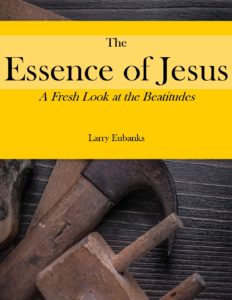
Impossible
 A Message Delivered on Christmas Eve, 2014
A Message Delivered on Christmas Eve, 2014
When you read the gospels it is evident that the birth narratives of Matthew and Luke aren’t the same. That’s because Matthew and Luke aren’t interested in telling what happened, but what it means.
Matthew says everything he wants to say with Magi, and Luke says everything he wants to say with shepherds, but John—well, for John to be able to say what he wants to say, he’s got to go back to the beginning.
When John starts his gospel with the words, “In the beginning,” he’s taking his readers back to Genesis, to the creation account found in chapter 1.
In the beginning was the Word, and the Word was with God, and the Word was God. He was in the beginning with God. All things came into being through him, and without him not one thing came into being. What has come into being in him was life, and the life was the light of all people. The light shines in the darkness, and the darkness did not overcome it. (John 1:1-5 NRSV)
In Genesis 1, when God begins to shape the world, there is nothing but darkness, and the first thing he does is create light.
Light—that mysterious luminosity which defines the outer limits of speed.
Physicists will tell you that things either have the properties of particles or of waves. One or the other, but not both.
Except light. Light sometimes acts as a particle, other times acts as wave.
Light transcends either/or; it’s both/and.
It’s supposed to be impossible, but there it is, showing us that our categories of what is possible and impossible are inadequate for describing reality.
Like when we say that God is three yet one. Particle and wave. Both/and.
Without light there is no life, so it’s the first thing that’s created. When God created light, he created life.
So says John: “What came into being in him was life, and the life was the light of all people.” (vs. 3-4)
Then in verse 14 John says,
And the Word became flesh and lived among us, and we have seen his glory, the glory as of a father’s only son, full of grace and truth.
This Word became flesh and reflected the image of God to the world.
Like father, like son. The spitting image of his old man.
When John says this he’s reminding us of the sixth day of creation in Genesis 1, when God creates humankind in his own image.
So God created humankind in his image, in the image of God he created them; male and female he created them. (Gen. 1:27 NRSV)
Humankind, the spitting image of God. See one, you’re seeing the other.
Unfortunately that didn’t last long. It wasn’t enough for us to bear God’s image. We wanted to act like gods, deciding for ourselves what is right and wrong—and often wanting to decide for others what is right and wrong.
From there it’s just a small step to deciding who is right and who is wrong.
And it’s not as large a leap as you think to go from there to deciding who deserves to live and who deserves to die.
We do that all the time.
And instead of becoming more like gods, we became less like God in the one respect that mattered: we were no longer spitting images of the Father.
We no longer reflected the image of God.
The image became distorted. Just a little at first, but the more we descended into fear and suspicion, the more distorted the image of God became.
And fear and suspicion made it more difficult to see the image of God in others.
Soon our brothers were no longer our brothers and we weren’t their keepers.
Our brothers instead became our rivals, our competitors, our enemies.
And the more we didn’t see the image of God in them, the easier it became to kill them. And the more we killed, the more distorted the image of God became.
And soon the earth was filled with violence.
The thing is, it’s not like we had a picture of God that we could refer to and say, “Oh, yeah, that’s what God looks like. That’s what we’re supposed to look like.”
With no point of reference, with only each other to look at, we began to envision that God was, well, like one of us.
Wanting the same things.
Loving the people we love.
Hating the people we hate.
Wanting dead the people we want dead.
So we made God in our own image. We envisioned him wiping out whole villages of men, women and even children.
He was a God with some serious anger issues, who took account of every slight, however small, and demanded that someone, something, somewhere was going to pay a penalty before he’d calm down.
That’s the god we envisioned, because that’s how we do things. If you do the crime, you must do the time.
The problem was that there was no image of God on earth that we could look at and see how God really was. All the images had become marred, distorted.
It was like looking at a Picasso, with an eye over here and an ear over there.
So, John says, God took on flesh, the Father sent his son full of the Spirit, one in three and three in one, wave and particle, once again our categories of possible and impossible not being up to the task of describing the reality of who God is.
God did a do-over. A human bearing the image of God because he is God.
Human and God, wave and particle, unbelievable, impossible, yet there it is.
And he shows us who God really is. As John says, full of grace and truth.
Full of grace, not judgment.
Full of love, not anger.
Inviting love, not fear.
Bringing life, not death.
Light, not darkness.
And truth. No distortions. A true image of God.
But that’s only half of it. You see, when we tried to be like gods, we became inhuman. We marred not only the image of God in us also but the image of humanity in us.
We no longer could see what it meant to be human, with the result that we became sick with the disease called inhumanity.
This disease clouds our thinking and distorts our vision so that we no longer know what’s right and what’s wrong.
What we needed was someone to not only show us who God is, but what it means to be truly human.
And that person, John says, is Jesus.
That’s why John’s gospel has the resurrection take place in a Garden, with Mary thinking Jesus was the gardener. She thought that because he was the First Gardener redone.
Paul called him the second Adam.
Adam Again.
Adam Rebooted.
A man, in the very image of God, as God intended him to be.
So Jesus shows us not only who God is, has always been and always will be.
Jesus also shows us who we once were, and will be again.
Unbelievable? Impossible? Maybe.
But apparently the truest things are.
Image by © Can Stock Photo Inc. / wenani
 I am a lifelong student of the Bible, and have been a pastor for over twenty-five years. My desire through this blog is to help people see things in the intersection of Scripture and real life that they might have missed. The careless handling of the Bible is causing a lot of problems in our churches and our culture--and is literally turning people away from the church, and, sometimes, God. I hope to treat Scripture with the respect it deserves, and, even if you don't agree with what I say, give you some insight.
Feel free to leave a comment. I promise to respond to you. All I ask is that you be respectful in your comments.
I am a lifelong student of the Bible, and have been a pastor for over twenty-five years. My desire through this blog is to help people see things in the intersection of Scripture and real life that they might have missed. The careless handling of the Bible is causing a lot of problems in our churches and our culture--and is literally turning people away from the church, and, sometimes, God. I hope to treat Scripture with the respect it deserves, and, even if you don't agree with what I say, give you some insight.
Feel free to leave a comment. I promise to respond to you. All I ask is that you be respectful in your comments. 
Connect with Me